CAMPECHE CITY
Tourism in CAMPECHE CITY
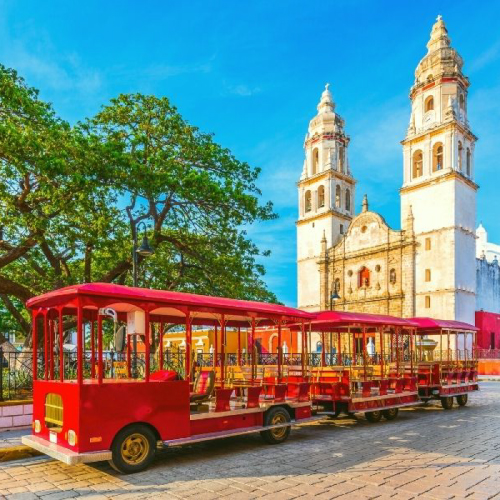
Since the year 800 B.C. the Mayas flourished in Campeche and developed cultures known as Chenes, Puuc, Río Bec and Peten. In 1531, Francisco de Montejo founded the Villa de Salamanca de Campeche, and in 1540 his son who was called “el Mozo” (the youthful), founded the “Villa de San Francisco de Campeche”. During the colony the pirates assaulted the ports and the cities by the sea. This situation forced Campeche’s inhabitants to build forts, bastions and walls around the city.
Campeche is a city immersed in the typically colonial atmosphere with towers, bastions and walls. The traveler can enjoy all the city’s attractions on board of one of the old time vehicles replicas named “El Guapo” (the handsome one) and the “Tranvía de la Ciudad” (City’s Tram).
The state of preservation and quality of its architecture earned it the status of a UNESCO World Heritage Site in 1999. Campeche is famous for its excellent gastronomy based on fish and seafood, some of the famous dishes are: pompano in tin foil, grouper in its own juice, pan decazón, squids in their own juice,breaded shrimp, and Campechana style fish.
A short distance from Campeche are Sihoplaya and Seybaplaya, white sandy beaches with shallow and transparent waters. Its climate is hot and semi-humid with an average temperature of 75ºF.
Tourist Attractions in CAMPECHE CITY
Since its foundation in 1540 by Francisco de Montejo “El mozo”, San Francisco de Campeche became the second most important port for the Spanish colony, only behind Veracruz. Reason why bastions were built to take care of the interests of the Colony. Campeche became a port of entry and exit for products from New Spain, which made it a target for pirates, buccaneers and corsairs from different parts of Europe.
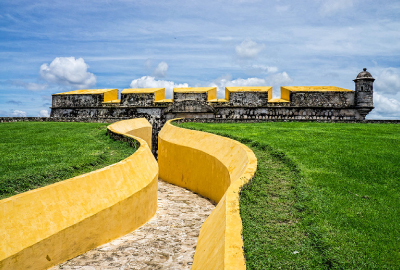
In 1661, a flotilla of pirates under the command of Henry Morgan raided two Spanish merchant frigates and withdrew without a fight. Two years later, the Dutch corsair Mansvelt or Mansfelt attacked the Villa de San Francisco de Campeche, and left great damage to homes, infrastructure and people’s lives. As a result of these attacks, the Governor had to ask the Spanish Crown for help to build forts and thus be able to defend the interests of the colony. At that time the naval military history of Campeche began.
In the 16th and 17th centuries, its walls and fortresses began to be built, the first to be built being the “Torrecilla” which later would become the Fort of San Benito. Some time later, it was endorsed that the City of Campeche be walled, beginning its construction in 1684 and concluding in 1704, when the pirate attacks had almost disappeared.
The wall was 2,560 meters long and consisted of an irregularly shaped polygon with six fronts, four gates and eight bastions. It was also guarded by two forts built on the nearby hills. Currently only 500 meters of wall are preserved, two gates, two forts and eight bastions: San Juan, Santa Rosa, San Carlos, San José, San Francisco, San Pedro, San Miguel and La Soledad whose spaces have been adapted as meeting rooms. exhibitions with weapons of the time and function as museums and gardens.
Bastions in CAMPECHE
Bastion of San Juan
His name is linked to that of San Juan de Dios, founder of the order of the Juaninos. This construction dates from the 17th and 18th centuries and has an area of 764 square meters. It is currently one of the only bastions attached to a wall, It is a unique structure that was part of the big wall.
Santa Rosa Bastion
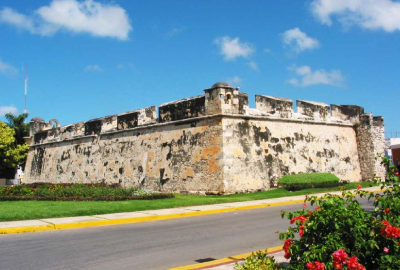
It was the first to be completed of the eight bastions. It was named in honor of the first sanctified American: Rosa de Lima. It is a building that dates back to the 17th and 18th centuries, built with quarry stone and sahcab. It has a pentagonal base with an interior court.
It was part of the city’s defense system and was later used as a neighborhood. Its surface was 1,157.45 meters, it currently houses the Pinacoteca Campechana, which houses paintings and plastic pictures by Campeche artists.
Bastion of San Carlos
It was the first built in 1686. The home of the City’s Museum, with an interesting photographic exhibit of old times Campeche, as well as the walled city descriptive models. The name is in honor of Carlos II and covers 840 square meters. Today it houses the Museum of the City, with all the documents from the colonial era and later. It is said that the famous Dutch pirate Kornelius Jols arrived here, who attacked the town in 1633, commanding ten ships full of corsairs.
Bastion of San Jose el Bajo
The Baluarte de San José el Bajo, is the eighth bastion and received its name in honor of the husband of the Virgin and earthly father of Christ. It was located in one of the parts of what is now the Justo Sierra Méndez elementary school and was one of the bastions demolished during the first decades of this century.
Bastion of San Jose el Alto
Built in the 18th Century, in its rooms has a permanent exhibit of paintings, objects and models of the colony.
Bastion of San Francisco
It is located next to the bastion of La Soledad. This bastion was the largest with 1,342 square meters. His name pleased the Franciscans, since the clergy had to contribute their donations for the construction of these great works. In 1889, with the permission granted for the installation of the city tram, this bastion was demolished in its middle part, giving way to the rails that would lead to the Santa Ana neighborhood.
Currently, together with the bastion of San Juan, it is part of the sound and light show of Puerta de Tierra attached to this bastion. Once the part that divided it into two was rebuilt, a vaulted auditorium was refurbished. Built to protect the Land Gate.
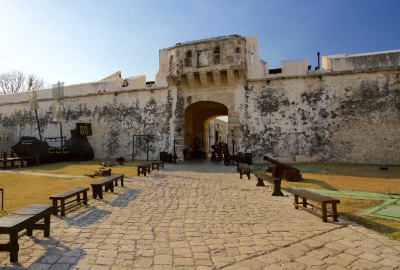
Puerta de Tierra (Land Gate)
The Land Gate was one of the four accesses to the city, and its protected by San Francisco’s and San Juan’s Bastions, which are linked by long wall fronts that were more than 8 meters tall, where the quarrels between pirates and campechanos can be revived in a light and sound show named “El Lugar del Sun” (The place of the Sun).
“El Lugar del Sol” (The place of the Sun)
It takes place in the “Puerta de Tierra” of the Historic Center Plaza Principal, it tells the story of the city of San Francisco de Campeche, since the Mayans settled on the coast, the conquest and the pirate attacks. Accompanied by the guide of a watchman, part of the wall is covered to culminate with a play of lights, sounds and actors representing Mayans, pirates, Spaniards and Franciscan friars.
Bastion of San Pedro
This was the sixth fortification built during the walling of the city. It has a quadrangular-type floor plan, so its four walls faced the outside, and it still boasts the four sentry boxes on its corners.
Its access door shows on the lintel a shield with the papal tiara, which is the symbol of Saint Peter, and inside there is a small patio with a staircase that leads to the roof, where it is possible to see the sentry boxes. One of them had a bell that alerted the population in the event of an attack and another still has its latrine.
Bastion of San Miguel
The Fort of San Miguel is located to the west of Campeche. This work was completed in 1801 and has a drawbridge, guardhouse, officer’s room, gunpowder store, its access corridor is wavy, which prevented enemy access.
Built in the 18th Century has old cannons and the Mayan Culture Museum with an exhibit pieces of the prehispanic and colonial times. It is currently a museum that contains some steles that were found in the archaeological zone of Calakmul and Edzná.
Puerta de Mar (Sea Gate)
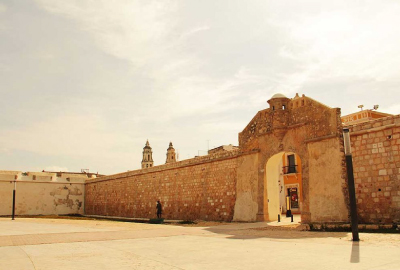
It has a simple facade, in the big door there is a galleon carved in stone. It was the first of the accesses built and the first to be demolished at the end of the 19th century. For two centuries it was the entrance and exit for those who used the only means of communication at that time: navigation.
It lacked a moat and a ravelin, in front it had a jabín stockade. In the 1800s, two corridors and a portal were added that served to house the sentinels who guarded it, similar to the body of guards in the powder keg. In 1957 it was rebuilt, but it was not until 1997 when it was joined again by a stretch of wall to the bastion of solitude.
Bastion of La Soledad
Its construction dates from approximately the end of the 17th century and it was the third in the city’s defensive system, as well as one of the most important due to its proximity to the Puerta de Mar (Sea Gate). Built in the 17th Century, has remains of the wall in one side. Since 1958 there is a Museum with Archeological, Ethnographical and Historical pieces.
On one of its sides it preserves part of the old wall, the roundabout, battlements and sentry boxes. Access to the bastion leads to a large patio that served as the entrance to the different rooms of the building, where the soldiers were stationed and weapons and gunpowder were stored. On one side of the patio you can see the ramp that leads to the roof terrace and the roundabout, from where you can see the sea and the city.
Santiago Bastion
It was built in the 18th Century. This bastion was the last of the eight to be completed, its current form differs greatly from the original, which was similar to that of San Carlos, currently at the top of its entrance it reads 1704, although it does not exactly correspond to the date of the completion of the entire completely walled enclosure, this was completed shortly before 1710. The modest current construction houses a Botanical Garden called “X’much-Haltún” with an interesting list of plants from the region.
San Matías’ Battery
Together with the San Lucas battery, they defended possible landings towards windward, they were on the coast at the foot of the San José redoubt. It still retains the ramp that leads us to the top of its solid structure. In periods of high tide it used to be surrounded by the sea.
San Luis’ Battery
It was built at the foot of Fort San Miguel, on the leeward coast, in the last third of the 18th century. It is in a perfect state of preservation, unlike others that have disappeared over time. Its plant is rectangular and it is surrounded by a moat, two flown sentry boxes look towards the sea. It is currently protected by the Secretary of the Navy and can be visited as a tourist attraction in the city.
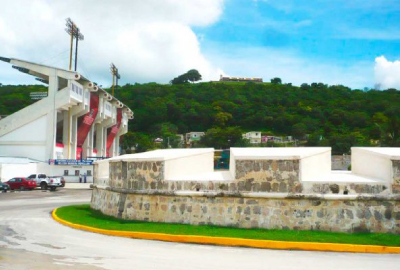
San Lucas’ Battery
On the foundations of this battery the wall that surrounded it was rebuilt. It was part of the windward fortification and is part of the set of new fortifications that by 1792 had already been completed to reinforce the Plaza de Campeche. Currently within its perimeter there is a neighborhood and only the exterior view of the wall remains as a trace of its existence.
“La Casamata y El Polvorín” (The Casemate and the Powder Magazine)
The Polvorín is one of the military buildings that was built on the outskirts of the town of Campeche during the 18th century. It was built on top of a small hill called El limonar, located just over four kilometers from the center of the town in a southeasterly direction. This building was intended to store gunpowder, and 160 meters from it, another for housing the officer and troops that guarded it.
The first building for the gunpowder store consists of a barrel-vaulted gallery, surrounded and protected by an open space in the form of an atrium, limited by a masonry wall, which in its northwest corner contains a sentry box with its corresponding loopholes. The second building intended for the accommodation of the officer and the troops, is made up of a terrace or patio with masonry parapet surrounding the rooms on three of its sides, composed in turn of a portal with semicircular arches and two more pieces.
All roofless and with its masonry walls. Near this construction is another smaller one. Currently, this building is completely rescued and enabled as a Cultural Center.
Religious Architecture in CAMPECHE
The Cathedral of Campeche
Dedicated to Our Lady of the Immaculate Conception. It is the main Church of the Diocese of the same name, seat of the Bishopric. It is located in front of the Plaza de la Constitución of the city. The rank of cathedral was granted in 1895 by Pope Leo XIII. It is a baroque-style building with neoclassical features, famous for housing figurines of sacred art in its interior, highlighting a monument called “El Santo Entierro” that represents a coffin with the figure of Christ and that during Good Friday is carried by the main streets of the city.
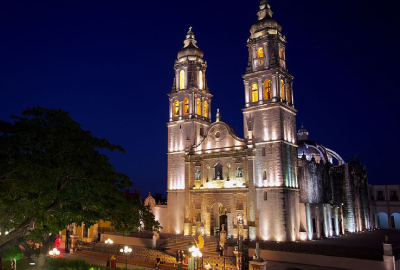
Church of San Roque and San Francisquito
Built in the mid-seventeenth century (1634), based on quarry stone and masonry. Architecture with Franciscan modalities. Solid building surrounded by battlements, highlights a belfry that looks back and another in the front. It is of a single nave; with a beamed ceiling, it has baroque altarpieces, four altars, one of them central in Solomonic baroque style.
Church of Santa Ana
Built in the year 1735 based on quarry stone and sascab. The portal is made up of a main semicircular arch, with an iron gate and fluted pilasters on its sides, a coral window with a railing, a two-part belfry and battlements on the walls; the ceiling is vaulted with a single nave with a semi-orange dome; it has side chapels: the floor plan of the church is in the shape of a Latin cross.
Church of Nuestra Señora de Guadalupe
Its construction dates back to the last third of the 16th century and apparently was completed in 1660. It was dedicated to the cult of the Virgin of Guadalupe de Villuercas from the Spanish region of Extremadura, since there were many Spaniards from that region.
Towards the 18th century, the force of custom caused the cult to be transferred to that of the national Guadalupana. The temple has a very simple façade, with its semicircular arch at the access door, a balcony as a choir window and a bell tower on its left side.
Temple of San Roman
It was built towards the middle of the 16th century. It has a simple facade in a very sober style, the door is a semicircular arch barely decorated with discreet moldings and has a coral window above it. The enclosure is flanked by a simple tower with two bodies, the upper one with a clock between ogee arches.
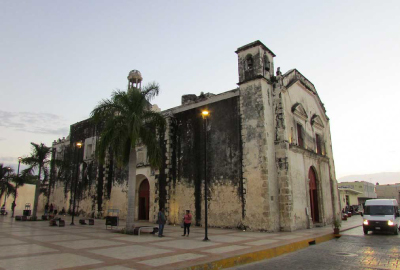
Church of San Juan de Dios
It is the sixth fortification built during the walling of the city. It has a quadrangular floor plan, so its four walls faced the outside, and it still has four sentry boxes on its corners. Its access door shows on the lintel a shield with the papal tiara and the keys to heaven, which is the symbol of Saint Peter, and inside there is a small patio with a staircase that leads to the roof, where it is possible to see the garitons One of them had a bell that alerted the population in the event of an attack and another still has its latrine.
During the 19th century it played a very important role during the battles it had against the Mérida government and against General Santa Anna, its function was as a refuge for the troops as well as an ammunition and gunpowder depot. Possibly its purguero witnessed tortures carried out in the 18th century during the so-called Holy Inquisition. In this construction, a dome crowned by a lantern stands out in which a fire was lit as a sign that it was a hospital.
Church of San Francisco
Franciscan missionaries founded the first Franciscan convent in the year 1546 on the land of the indigenous town of Kin Pech, one mile from the Villa de San Francisco de Campeche, in the same place where the first mass was celebrated in the current Mexican territory around 1517.
Significant historical events took place in this convent, such as having offered hospitality to the wife of Martín Cortés -son of the conqueror of Mexico-, who gave birth there on October 31, 1562 to a man named Jerónimo, baptized in that place. by Bishop Don Francisco de Toral and having Don Francisco de Montejo as godfather.
Former Temple of San José
Undoubtedly one of the most beautiful in the city due to its façade, which exhibits a modest baroque style in which the use of Talavera-type tiles admirably stands out, as a complement to a decoration that as a whole offers a certain Moorish air. The building was erected by the Jesuits around the year 1716, on the site of another old temple dedicated to Saint Joseph, patron saint of carpenters and shipbuilders.
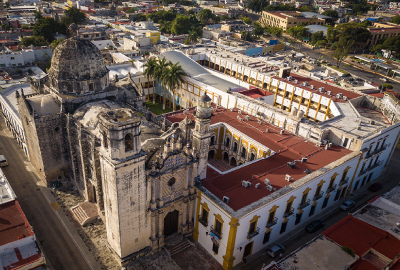
Its interior has a Latin cross floor plan and only remains of its choir and a small gallery that were probably used to hear mass from the old annexed college, which the Jesuits built and which functioned until the date of their expulsion in 1767. Today the old temple building is used as a gallery for events and cultural exhibitions, while the adjoining building, where the school used to be, is today the Campechano Institute.
Church of the Dulce Nombre de Jesus
Built in the 17th century based on quarry stone and sascab. It is a solid building with thick walls, supported by buttresses and surrounded by battlements, some built in the 17th century and others in the 18th century. The façade is made up of a main entrance with a semicircular arch with a wooden door, a coral window and a two-part belfry. The building is surrounded by an iron fence supported by columns.
Church of Santa Lucia
This is a typical temple, with the Franciscan style that prevailed in most of the churches in Campeche. Its main façade has an access formed by a semicircular arch supported by Tuscan columns; crowned by a coral window and in the upper part by a belfry in a mixtilinear form in which four semicircular arch openings can be seen as bell towers.
On the sides of the belfry, pyramidal finials can be seen. The cover is of sober characteristics in stonework with lateral walls supported on buttresses. Its interior is very simple, it is a single nave with a vaulted beam ceiling in the form of a continuous barrel.
Civil Architecture in CAMPECHE
Library of Campeche
The Campeche Library represents an invaluable space rich in history and modern technology that makes one reflect on the magnificence of the city’s roots. When the Spanish settled in 1540 and named Villa de San Francisco e Campeche to this region, the governmental structure established by the Mayans changed, as well as its urban layout.
In this way the buildings that were erected around the square would be the most relevant for the population; political, military, religious and later commercial power. The second half of the 18th century, and in particular the historical cycle opened by the Bourbon reforms, meant for Villa de Campeche and its jurisdiction the beginning of an era of prosperity. The main powers were located inside the wall. Within which the annex stands out in 1779 according to the plan signed by Agustín Crame, of the Town Hall House, or House of the Cabildo, being the building of maximum political power.
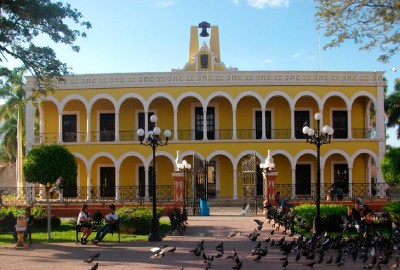
Due to political changes, Campeche as an independent state from 1857, has to change its structure, so the Municipal Palace, which was the seat of highest authority in the city, is modified. With the title of city it is necessary to implant buildings around the square, and in 1858 Campeche needed a Government Palace to establish the executive power, being located to the right of the central axis. In this way, from 1962 the cycle of the colonial city ends to give way to a modernist one; the Municipal Palace, the Government Palace and the Maritime Customs are demolished.
It is during the year 2000 that the construction of the Campeche Library begins with the intention of rescuing its structure and recovering part of its former splendor; This is built on the north side of the Plaza de la Independencia in the Historic Center of the city of San Francisco de Campeche, a building with the same proportions and dimensions as the one that occupied the town hall since the 18th century.
In this way, the reconstruction of the town hall house is a contemporary work inserted in an old urban fabric that should have adhered to the pre-existing urban organization, respecting the historical and congruent parcel of the surrounding environment, through the architectural characteristics of proportion, scale, materials, color and ornamentation of the urban environment. All this with two specific objectives to create a space of cultural and technological wealth channeled to the Campeche community, so on June 5, 2003, the Campeche Library opens its doors.
Tram ride through the historic center and the city’s forts
Take a tour of the main sites as well as historical monuments of the city of Campeche Cultural Heritage of Humanity. Passing through the traditional neighborhoods, along the city’s boardwalk, on other of its routes you can also go to see “the forts” of the city: San Miguel and San José, both located on the top of the hill as faithful lookouts of the city.
Pirate ship “Lorencillo”
Take a tour of Campeche Bay, which hundreds of times was invaded by corsairs and pirates like Sir Francis Drake, the place where that ship departs from is perfect to taste different typical dishes and have a pleasant moment with family or friends.
Municipal Archive
Built in the 19th Century, first it was a school and then a prison. This archive has documents from the legal, administrative and civil memory of the city of San Francisco de Campeche, a collection that covers the 19th century to date.
The building, built on one level, has a simple facade with seven windows, two vertical and two horizontal on the right side of the access and three horizontal on the left side. The central gate is formed by an arch delimited by pilasters with a capital topped by a thin double molding and above this a cornice from which the two simulated pilasters and capitals continue, topped in turn by another cornice, which runs the entire length. of the permanent wall of cannons in the city.
Finishing off the central gate is a belfry in the shape of a bell with a molding that runs along its contour, inside there is an empty niche that ends with a limestone cross. On the left side of the main access there is a sentry box built at the time the building was used as a jail.
Carvajal Mansion
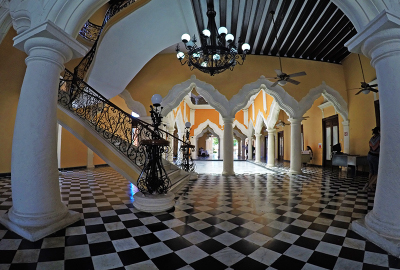
House built in the 17th Century with a Moorish style. Two-level building of aristocratic colonial design, built at the end of the 17th century. The main hall stands out for being divided by Moorish-type mixtilinear arches supported by Doric columns. A majestic marble staircase stands out, the railings of the stairs, the windows and the balconies are artistically forged ironwork.
Located on Calle 10, between 51 and 53, this construction from the early 18th century is an example, of the few that exist in the city, of the Arab influence, we can appreciate this by its multi-lobed arches that give it its own personality.
Musical Fountains on the Esplanade of the World Heritage Square in the Historic Center
It is an interactive musical fountain that allows unifying the height of the different torrents of water, as well as its design that evokes the concept of military architecture in the city.
Historical Center
In it you will find the most representative of the colonial era in each of the houses that with their sober beauty in their facades, showy gates and stately windows are unique in the southeast.
The architecture of the colonial times and subsequent periods represent more than 452 years of work, with religious buildings such as the Cathedral, the walls of Campeche are also testimony to the colonial era that revives and is breathed at every step through the streets of the city.
Cultural Center “Casa No. 6”
It offers a reconstruction of a typical house of the Campeche upper classes from the 17th to the 19th centuries. The house is on one level, consists of a gate framed by quarry jambs and lintels and crowned by an undulating molding in the form of a pediment, topped by a cross. On the façade you can see its four windows with dust covers, pedestals and huge wrought iron bars, characteristic elements of local architecture since the 18th century. It currently functions as a bookstore, cafeteria, craft store and tourist information module.
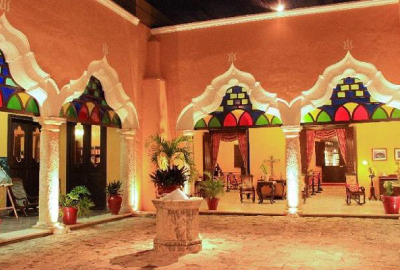
Campeche Institute
The Meritorious Campechano Institute is one of the Mexican schools with the greatest tradition. Founded in 1859, it achieved popularity in the second part of the 19th century and the beginning of the 20th.
Government Palace
This building represented in its historical moment, the emblem of an architectural renewal of this capital city, promoted by Governor José Ortiz Ávila, according to the modernist vision of the sixties.
Campeche Main Park
This work was carried out at the end of 1540 and had a remodeling in 1826, it was called Plaza de la Independencia, it was modified again in the 20th century in the decades of the 30s, 60s and 80s. Now it is a limited square with a fence of ironwork with six access doors of the same material. In the middle there is a 16-sided kiosk with eight entrances and 24 columns, the roof is made of zinc sheeting, crowned by a small dome. It is richly ornamented with natural vegetation that evokes the bucolic tropical atmosphere.
Bridge of the Mercedes (of the dogs)
Built in the 19th century (1888), by order of Colonel Francisco de Paula Toro and with the title of Merced de Santa Ana, under the direction of friar José de la Luz Solís. It is supported by an arch and four dog sculptures in the corners.
Building that houses the House of Culture
Built in the 18th century (1724), based on quarried stone and masonry. It has a cloister flanked by semicircular arches, which has a cistern in the center; it is roofed with log. It was built as an annex to the Church of San Francisquito, it functioned as a convent and later as a hospice. At the beginning of the 20th century it was used as the seat of the State Congress; later it was abandoned until 1976, when it was restored to house the House of Culture of the Campeche municipality.
Lerma Lighthouse
This lighthouse offers a view of Campechana Bay and for many years this lighthouse witnessed the construction of many shrimp boats that were exported all over the world, being the most important shipyard in the Gulf of Mexico at the time.
Campeche old lighthouse
Perched on one of the towers of the San José temple, is the most elegant lighthouse in Campeche. Of English construction, its installation dates back to 1864 and represents the first signaling of this type on our coasts. Its elegance stands out when observing the talavera façade of the Ex-Temple of San José. Its metal dome topped by a wind vane shows the elegance in the constructions of this time. Today, the old San José Lighthouse continues to stand out on the panoramic views of Campeche, to the delight of the inhabitants of Campeche and visitors who seek to explore the beauties of the Historic Center.
San Francisco Square
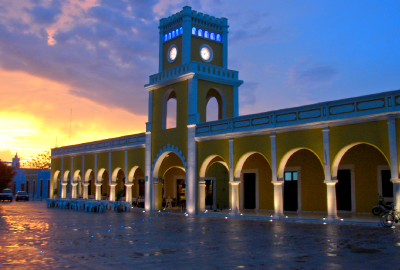
To one side of the Plazuela de San Francisco, built in 1737, is the Church of San Francisco. This square is characterized by having a tower with a clock made in 1861 and for being always lively at night thanks to the picnic areas. There are also the remains of the San Lucas battery, built around 1782, it remains facing the sea near the square.
Malecón (Pier)
This monumental work is a place of rest and family life. The boardwalk extends from the Justo Sierra Méndez monument to Joaquín Mucel avenue, with a length of almost 3.5 kilometers, and was inaugurated on August 10, 2000. It has two expressways with three lanes, a low-speed road with two lanes, three pedestrian crossings and a central median six meters wide.
It has a track for cycling and skating, one more for jogging, which go from start to finish of the work, as well as viewpoints where recreation areas were built that have become meeting places for families, who come to enjoy the sea breeze and the Campeche sunsets.
59th Street “Tourist Corridor”
59th Street is emblematic for its historical importance. It is the one that united the sea with the land and that has buildings of interest along its entire length, like the previous districts, you can enjoy it with its new clothing, its old houses, with the same facades painted with a range of pastel tones, which gallantly they provide shade both at dawn and at dusk, now that it is a tourist corridor, it offers passers-by the atmosphere of a city encapsulated in time, but alive.
Joaquin Clausell Gallery
The gallery is located at Calle 12 number 173 in the Historic Center of the city of San Francisco de Campeche, and honors with its name José Joaquín Quirino Marcelino Clausell, who was born in the city of San Francisco de Campeche on June 16, 1866. , son of Catalans, studied at the Benemérito Campechano Institute, and later, he studied law in Mexico City; he stood out in journalism, a branch that he took advantage of to expose his ideas.
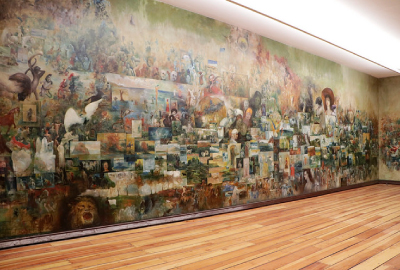
He settled in Europe, where he was impressed with art and began to paint; returning to Mexico as an important artist. His paintings stand out for their landscapes and beautiful seascapes, such as the Bathers, Clouds over Crops, the Force of the Sea, among others.
Domingo Pérez-Piña Art Gallery
The Domingo Pérez-Piña Art Gallery is a cultural space that provides all the facilities for any exponent and that offers an adequate area for the benefit of the community.
House of Crafts Tukulná
The Casa de Artesanías “Tukulná” (House of Thought) houses exhibition halls with various types of natural handicrafts from the state, such as Tepakán pottery, hammock weaving, hippie hat making, etc. Dresses, books, preserves, wood crafts, stonework, not to mention the fine work done in bull horn, which, due to its similar consistency, is an ideal substitute for hawksbill turtle shells, are also on display to the public which is in danger of extinction.
It is a space dedicated to preserving the customs, traditions and expressions of popular art of the people of Campeche. You can buy the finest pieces, a product of the craftsman’s ingenuity and inspiration.
Ah Kim Pech Craft Bazaar
Inaugurated on August 5, 2005 in San Francisco de Campeche, the Ah Kim Pech Craft Bazaar is a space created by the State Government where artisans from the different municipalities of Campeche exhibit and sell their products directly. Located on the city’s boardwalk, the Bazar has 37 stores that represent more than one group of artisan producers.
The variety of Campeche handicrafts that can be purchased at this place at the best prices is very wide: hammocks, rocking chairs, garden hammocks, hippie palm hats, hippie palm curiosities, hand embroidery, machine-embroidered hipiles, jewelry bone and bull horn, shell and snail jewelry, utilitarian wooden objects, handcrafted aromatherapy products, preserves, creams, chili sauces, fans.
Theaters in CAMPECHE
Circo Teatro Renacimiento
The Circo Teatro Renacimiento is a historical and cultural venue, located in the traditional Barrio de San Francisco, an area designated as Cultural Heritage of Humanity. In 1906, businessmen Cenobio Inclán and Rafael Alcalá Hernández had the idea of building a place that would allow all kinds of shows to be scheduled, thus the Renaissance Circus Theater emerged.
First, a wooden building was built, which was destroyed by fire, so a masonry building was built with the name of Nuevo Circo Teatro Renacimiento, which quickly became one of the favorite places of Campeche society. for the variety of shows and for the elegance of its facilities.
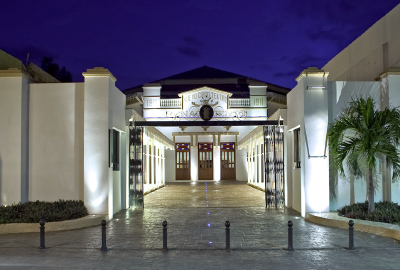
Between the 20s and 40s of the 20th century, different circuses, bullfights with distinguished matadors and constant programs of box fights were held at the Circo Teatro Renacimiento. It also functioned as an event hall, where both popular dances and civic events were held. The Famous Corona Caravan also arrived with singers, orchestras and comedians. Film functions of the so-called “Golden Age” of the National Cinema were included.
At the beginning of the 70’s of the 20th century, the Circo Teatro Renacimiento closed its doors and the building was abandoned for more than 20 years, until the Government of Campeche, through the State Coordination of Cultural Heritage Sites and Monuments , decided to rehabilitate it and return it to its former splendor, taking into consideration its great historical, architectural and social value, as the protagonist of an entire era in the life of the people of Campeche.
Now, the Circo Teatro Renacimiento has resurfaced to become the perfect setting for social and cultural events, to be a space where the past and the present come together for the coexistence and enjoyment of all.
Francisco de Paula Toro Theater (The Coliseum)
It is from the 19th century (1833), restored and modified in 1914. It is currently the theater of the city of San Francisco de Campeche, its exterior consists of a portico with four tall Doric columns and it is roofed with coffered ceilings, its interiors are decorated with balconies and wooden columns, saucer dome and wooden ceiling, its forum has a decorated arch supported by columns with fluted walls with wooden Doric capital.
Theater 401 Lic. Ignacio García Téllez
It was built between 1966 and 1967 and inaugurated on July 27, 1967 with the performance of the play “A Midsummer Night’s Dream” directed by Mr. Manuel Ávila Cano. The architect Luis Arriaga López was in charge of the remodeling in 2005, reopening on December 22 of that same year. Plays, music, children’s shows, festivals, conferences, assemblies and delegation reports are performed.
Joaquín Lanz Paullada University Cinema-Theater
Innumerable cinematographic projections have been made in it, as well as cultural events that promote art and knowledge throughout the municipality. It was inaugurated on July 1, 1967. Theater, music, dance, children’s shows, festivals, movies, conferences, assemblies and UAC administration reports are currently held.
Juan de la Cabada Theater
This cultural venue opened its doors in January 1989, since then it has been the venue for important plays and cultural events for the entire municipality.
Theater Hall of the Ministry of Culture
It is part of the facilities of the Ministry of Culture of Campeche. The space was adapted and inaugurated in January 2012.
Haciendas in CAMPECHE
Hacienda Blanca Flor
It was built in the 17th Century and is located in Hecelchakan. During the Caste War, in May 1848, defenders of the hacienda successfully fought off Maya rebels. Blanca Flor boasts an elegant but evocative 18th century ruined chapel (above), set dramatically on a hillside beside the old Mérida-Campeche highway, across from the hacienda itself. Through its gaping pedimented doorway, the visitor can glimpse the peeling painted walls of the sanctuary, abandoned and untouched for almost 100 years. Today, the Hacienda works as a beautiful Hotel.
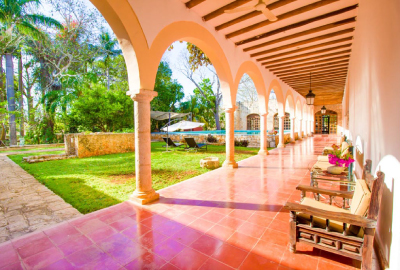
Hacienda Uayamon
Located in Campeche, in the 16th century it was a cattle breeding area, but it was untill the 19th century when the hacienda was a real example of modernity using electricity, railway, and giving educational and medical services to the workers. Today it is a luxury hotel.
This hacienda was founded in the last decade of the 16th century, to be used as a livestock production center. In the year 1685 it was the object of a bloody looting by the pirates Graff and Grammont. These buccaneers also attacked the city of San Francisco de Campeche. Uayamón continued as a ranch, in the seventeenth, eighteenth and early nineteenth centuries, it managed to position itself as one of the most powerful haciendas in the region. The rooms of the Hacienda Uayamón have been perfectly restored and exhibit a mixture of its original architecture with more contemporary details.
Hacienda Santa Cruz
Located in Calkini, it used to be an henequen field, built in 1866. It still remains its wide central yard (garden), the facade, the engine room, the storage room, the chapel of “El Santo Cristo del Amor”, and the original orchard, where jipi palm is growing today.
Hacienda San Luis Carpizo
Located in Champoton, it was a very important hacienda in the area. Today, it is occupied by the Mexican Army.
Hacienda Tankuche
Located in Calkini, it has a French style, simulating a medieval fortress. You can appreciate a wide central garden, the main house, and the engine room.
Museums in CAMPECHE
City Museum
The walled enclosure began with the construction of this bastion. Its name is in honor of Carlos II, in its 840 square meters of surface, today it houses the City Museum where items from the Colonial era are preserved, such as cannons and armor used at that time. In its interior vault there is a prison known as “the flea market” where the prisoners were locked up.
Mayan Culture Museum
In what were the old rooms of the soldiers, the warehouses, the kitchen and the magazine of this building, today an interesting sample of the pre-Hispanic and colonial history of Campeche is exhibited.
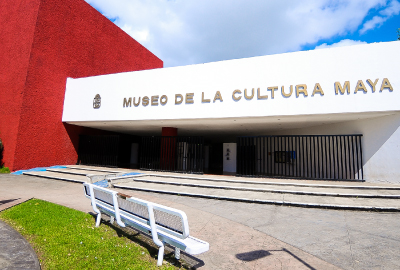
The magnificent ceramic pieces from various archaeological sites of the entity and the wonderful collection of jade masks found in Calakmul stand out. In the colonial part there are some pieces of furniture and scenes of daily life of that time, objects for domestic use and the remains of a beautiful rudder that was located in a branch of the Usumacinta River. In addition you can see a collection of ships and weapons. The final part is decorated with the symbols of trade and navigation.
Xmuch-Haltun Botanical Garden
The name of this pleasant site means in Mayan “water that springs from the earth”. The garden has an interesting sample of the entity’s flower, which includes a wide variety of plants, ranging from the most common to the rarest, which only grow in remote latitudes of the state.
Museum of Stelae Dr. Román Piña Chan
Housed in the old rooms of the old Baluarte de la Soledad, this museum exhibits an interesting collection of pieces and objects rescued from various archaeological sites in the entity.
The Mayan stelae stand out, some of great beauty and value. The pieces come mainly from sites such as Xcocha, Acanmul, Cayal, Edzná, Xcalumkín and Xculoc, among others.
Camino Real de Hecelchakán Museum
Housed in a small old house, it exhibits in five small rooms a simple collection of pieces from the Mayan culture, among which several stelae and ceramic pieces rescued on the nearby Jaina Island stand out. There are also illustrations and dioramas on the daily life of the Mayans and various historical events.
Mayan Architecture Museum
The museum has a display of diverse mayan objects. The Museum of Mayan Architecture (Baluarte de la Soledad) is a military construction from the end of the 17th century, it is located in front of the sea and represents one of the most important examples of the defense that the city of Campeche had. It is considered the largest of the eight that were built to unite the walled enclosure of the town of San Francisco de Campeche.
In 2005, this space was intervened, both in relation to the building, as well as in relation to the museum furniture, as well as in the contents of its speech. Its collection was enriched, reopening that same year with the name of the Museum of Mayan Architecture, Baluarte de la Soledad (formerly the Museum of Mayan Stelae).
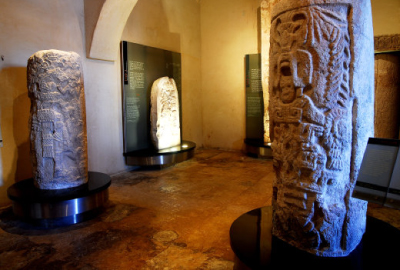
It currently offers a rich sample that contains architectural elements that come from four of the architectural regions of the Mayan culture, with which the entity has: Peten Norte, Río Bec, Chenes and Puuc. In addition, as part of the collection that is exhibited, it is worth mentioning the presence of the funerary trousseau from Structure VII of the Great Plaza of Calakmul, the bench from Rio Bec, the stone sculpture of the Lord Main Bird, from Chunhuhub, as well as the Mask of the god K’wiil, from the Villamar ranch. You can see columns, jambs, lintels, stelae, panels and anthropomorphic figures from sites such as Xcalumkín, Edzná, Itzimté, Kankí and El Palmar.
Museum of Mayan Archeology
This museum is made up of two unique collections of its kind in the entire Mayan area, one consists of the jadeite funerary masks from the tombs of the Divine Lords of Calakmul and the collection of funerary figurines from the island of Jaina. Likewise, stela number 9 from Calakmul can be seen, with epigraphic records of dates, names and images of one of its rulers and wives.
Other significant pieces are the plate with the lid of an iguana, with a great content of religious ideas expressed in an iconographic way, and the bowl with a lid in the shape of the head of a Black Jaguar or the Night Sun, both excavated in the Becan Archaeological Zone. From the House of the Itzáes or Edzná, the stone sculpture in the form of a drum in which the image of a queen appears.
In 1963 the building was rehabilitated to install the Museum of Weapons and Seamanship. In 1978 its collection was replaced giving way to the inauguration of the Mayan Archeology Museum. In February 2020, after an intervention to the building and the renovation of the museography, it was reopened as the Museum of Mayan Archeology. Fort of San Miguel.
Ships and Weapons Museum
It displays a series of colonial weapons and ships traded during the pirate era. The old rooms, occupied by soldiers and lookouts, today house an interesting historical exhibition distributed in five rooms. Here the visitor will obtain a general vision of what the city of Campeche was like when it was completely fortified; old paintings and stories of the fearsome pirates who attacked the city several times; objects that were traded through the port, weapons and beautiful models of some of the ships that were used for navigation, trade and piracy back in the 17th and 18th centuries.
Map of Tourist Attractions in CAMPECHE CITY
More Tourist Attractions in CAMPECHE
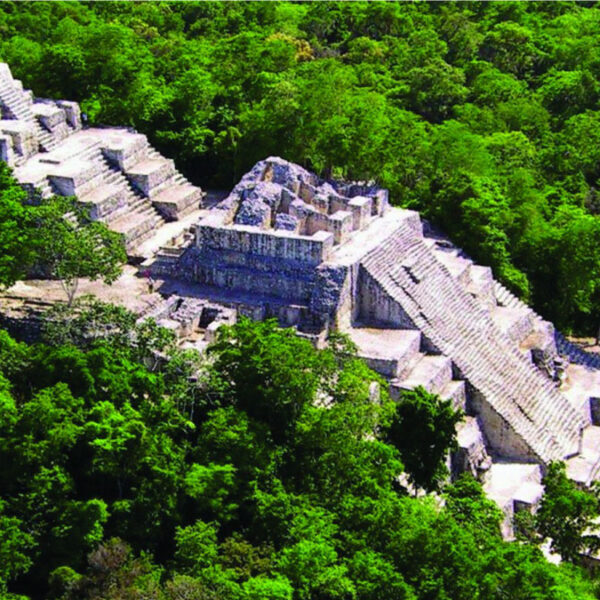
Archaelogical Sites in Campeche
The centers of the cities were filled with foundations for the temples, palaces, ball courts, astronomical observatories and rooms; like those seen in the Campeche Petén, the Puuc region, that of Los Chenes, that of Río Bec and that of the rivers and lagoons.… Read More
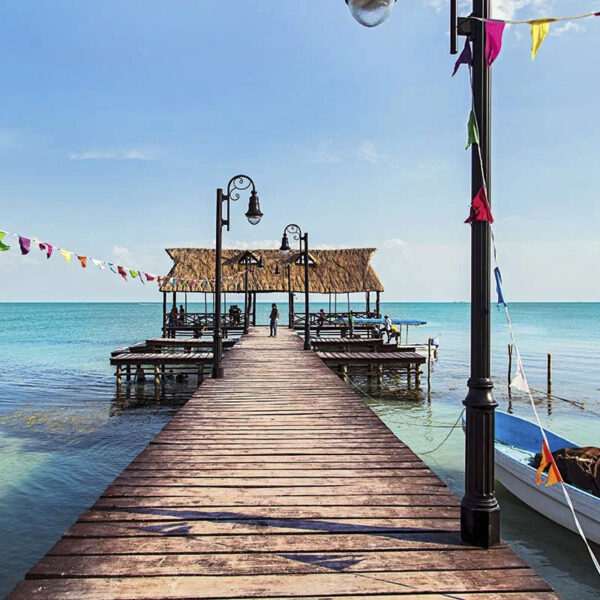
Campeche City Surroundings
Campeche is one of the states in the Mexican southeast that is worth visiting for its charming corners full of nature and cultural richness. Therefore, on this occasion, we present some of the most striking interesting sites in Campeche that will surely leave you speechless on your next trip. Take the best photos, fall in love with the best views, let yourself be surprised by its little towns full of history and learn more about the richness of this place.… Read More
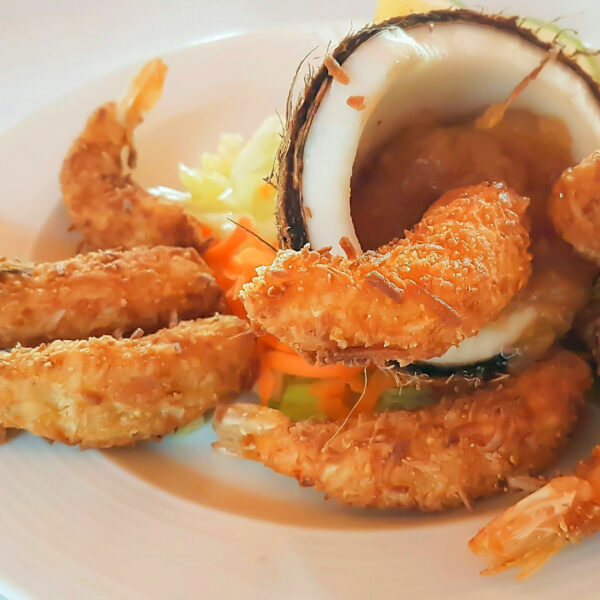
Gastronomy of Campeche
The state of Campeche is famous for its excellent gastronomy, unique and original for its creativity, seasoning and taste. Its gastronomic personality is the result of its Mayan heritage, combined with the contributions of the Spanish, and even pirates and corsairs also brought new components and forms of preparation in the various dishes that can be savored in the region today. Campeche has a wide variety of seafood, which has been fully used in its cuisine.… Read More
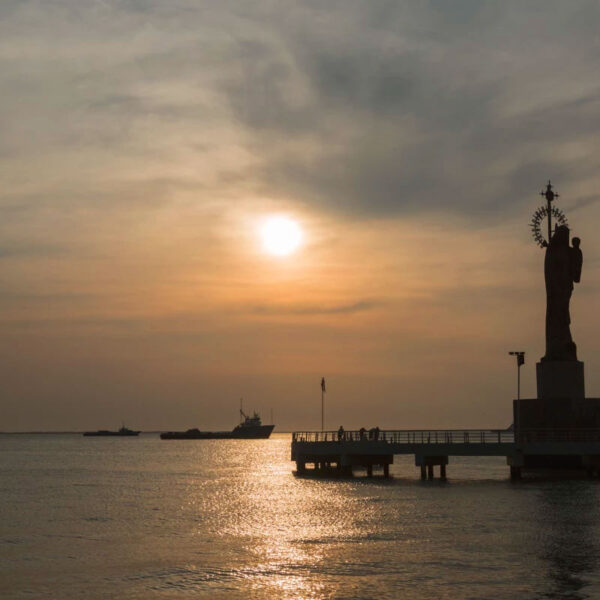
Ciudad del Carmen
It was founded during the pre-Hispanic period, and after the arrival of the Spaniards the island was populated mainly by pirates, it was known as
“Isla de Tris”. Cd. del Carmen has an extension of 6,353.3 square miles and is surrounded by beautiful landscapes with tropical vegetation. Also known as the Pearl of the Gulf, the island lies off the coast and is connected to the mainland by two bridges over the Laguna de Terminos, one of them with a length of more than two miles is the longest in Mexico. The natural attractions along with the archeological sites and the European style buildings in town, convert the island in a very apealing place for visitors.… Read More
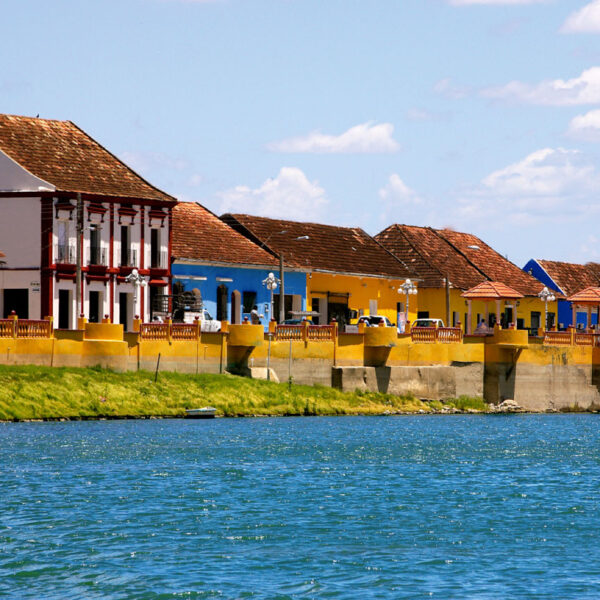
Magical Towns in Campeche
Among all the wonders of the state, there are also two of its magical towns: Isla Aguada and Palizada. Two ideal destinations to live under the colors of the sunsets, the beauty of its architecture and the legends of its streets.… Read More
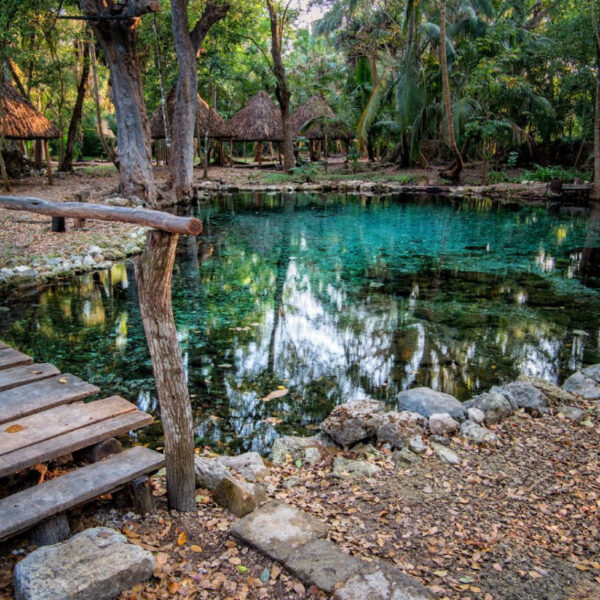
Ecotourism and Adventure in Campeche
Ecotourism in Campeche is lived between majestic jungles and mangroves, fill your vacations with unforgettable adventures! If you are looking to reconnect with nature and live it to the fullest, you will love ecotourism in Campeche. Get ready to go through jungles surrounded by tropical jungle and Mayan culture, mangroves and petenes surrounded by rich wildlife.… Read More
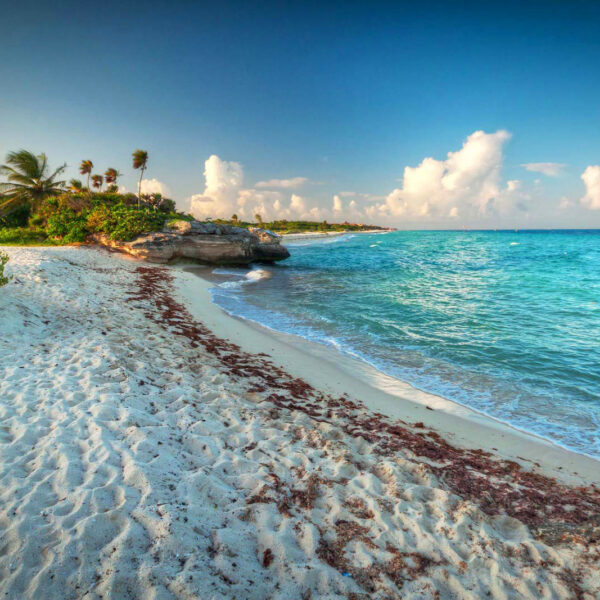
Beaches in Campeche
Thanks to the natural beauty that surrounds them, and the low presence of tourism, the state has some of the most beautiful beaches in Mexico. Its sand, which ranges from golden to white, and the tranquility of its sea, are oases away from the big cities and crowds, where you can relax and enjoy nature.… Read More
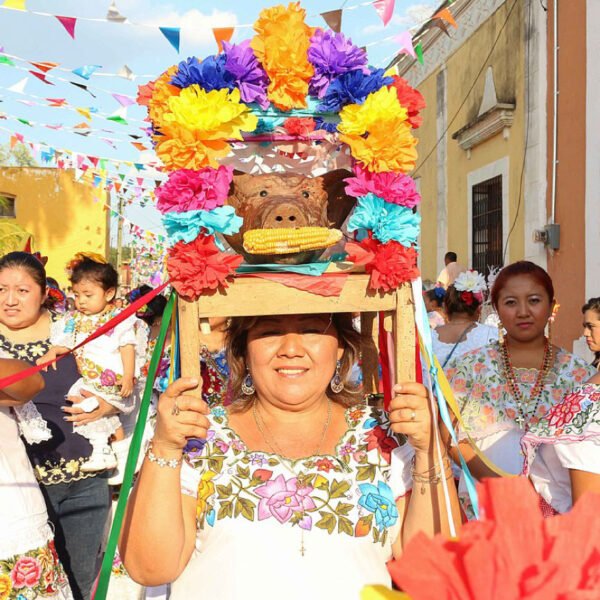
Traditions of Campeche
Campeche is without a doubt one of the most beautiful and traditional States of Mexico. Campeche is located in the southeast of Mexico and borders the states of Yucatan to the north, the state of Quintana Roo to the east, and the countries of Guatemala and Belize to the south. The capital of this State is called San Francisco de Campeche and it is also the city with the largest population in Campeche.… Read More
Flights & Hotels in CAMPECHE
More Tourist Attractions in MEXICO

Gastronomy
The Gastronomy of Mexico has a great diversity of typical dishes, which is why it was recognized by UNESCO as Intangible Heritage of Humanity. The basic and representative ingredients of Mexican dishes are: corn, coriander, chili, beans, piloncillo, nopal and tomato. Mexican cuisine is also characterized by its sauces, which serve as an accompaniment to traditional dishes, prepared based on spices.… Read More

Beaches
On the Beaches of Mexico you can immerse yourself in the intense blue ocean of the Pacific bays, sunbathe on the shore of the warm and transparent waves of the Caribbean Sea in Quintana Roo or even rest on the beautiful coasts of the Gulf of Mexico. Mexican beaches hide wonderful secrets for the traveler. By visiting them, in addition to enjoying the excellent climate and water activities, you can discover splendid archaeological sites and interesting colonial cities without traveling long distances.… Read More

Traditions in Mexico
It is practically impossible to make a meticulous, and above all, accurate selection of the places to visit in Mexico. Each place that our country houses is unique and beautiful in its own way. Mexico, with its nearly 2 million km², has a large number of scenarios to offer, as well as endless activities to do. Do not lose your way and enter the places to visit in Mexico. In Mexico, apart from the beaches and its famous archaeological sites, there are many other really interesting sites and activities that you should know. In the surroundings of the main cities you will find places full of culture and tradition, where you can spend relaxing, interesting and fun vacations. On your trip through Mexico you cannot stop obtaining souvenirs, the crafts that are made here are of the highest quality and recognized worldwide. A shopping tour cannot be missed.… Read More

Ecotourism and Adventure
Mexico is one of the best countries for Ecotourism as it has a great variety of flora and fauna, as well as a large number of refuges for extraordinary species. You can enjoy recreational activities of appreciation and knowledge of nature through contact with it, such as: stargazing, observation of natural attractions, wildlife and bird watching. Throughout México there are more than 176 protected natural areas, 5 of them considered by UNESCO as Natural Heritage of Humanity. Just for this and much more, we believe that Mexico is a Paradise for Ecotourism.… Read More

States Of Mexico
Mexico has an incredible diversity of landscapes, where the beauty of its beaches, internationally recognized, stands out. In its vast territory of coasts, there are beaches of unparalleled beauty, and colorful landscapes. A large network of first-class hotels and tourist services is available to visitors to these beaches. Mexico is also mystical places, dotted with archaeological testimonies inherited from its original inhabitants. Monuments made by the Mayas, Aztecs and Toltecs are located in magical landscapes, like lighthouses in an ocean of natural beauty. They offer visitors buildings that tell their history, and museums that collect their cultural heritage. And that keep alive ancestral traditions, in ceremonies and festivals, where you can enjoy cultural activities and entertainment.… Read More

Magical Towns
A Magical Town is a place with symbols and legends, towns with history that in many cases have been the scene of transcendent events for our country, they are places that show the national identity in each of its corners, with a magic that emanates from its attractions ; visiting them is an opportunity to discover the charm of Mexico. The Magical Towns Program contributes to revalue a set of populations in the country that have always been in the collective imagination of the nation and that represent fresh and varied alternatives for national and foreign visitors. A town that through time and in the face of modernity, has conserved, valued and defended its historical, cultural and natural heritage; and manifests it in various expressions through its tangible and intangible heritage. A Magical Town is a town that has unique, symbolic attributes, authentic stories, transcendent events, everyday life, which means a great opportunity for tourist use, taking into account the motivations and needs of travelers.… Read More

Archaeological Sites
The Archaeological Zones are the cultural past of every Mexican. You will be amazed at the ambient, nature and the environment that surrounds them. Climbing to the top or being around it will take us back in time to admire every detail. México is a country of culture and traditions, many of which we have inherited from the pre-Hispanic inhabitants of this vast territory, although it is true that there were more settlements in the central and southern part of the country, it is also possible to find some archaeological remains in the north.
… Read More

Capital Cities
Folklore, gastronomy, literary culture, art and exhibitions, is what you will find in the capitals of the states of Mexico. To the north, colonial Mexico, Puebla, Guadalajara, Guanajuato, the Sonoran desert and the California peninsula. To the east Veracruz and the gulf. To the west Acapulco, Oaxaca and Tuxtla Gutiérrez. And to the south the Riviera Maya and the pyramids of Chichén-Itzá, Tulúm and Cobá in Yucatán, Palenque in Chiapas, the cenotes, and the Central American jungles.… Read More

